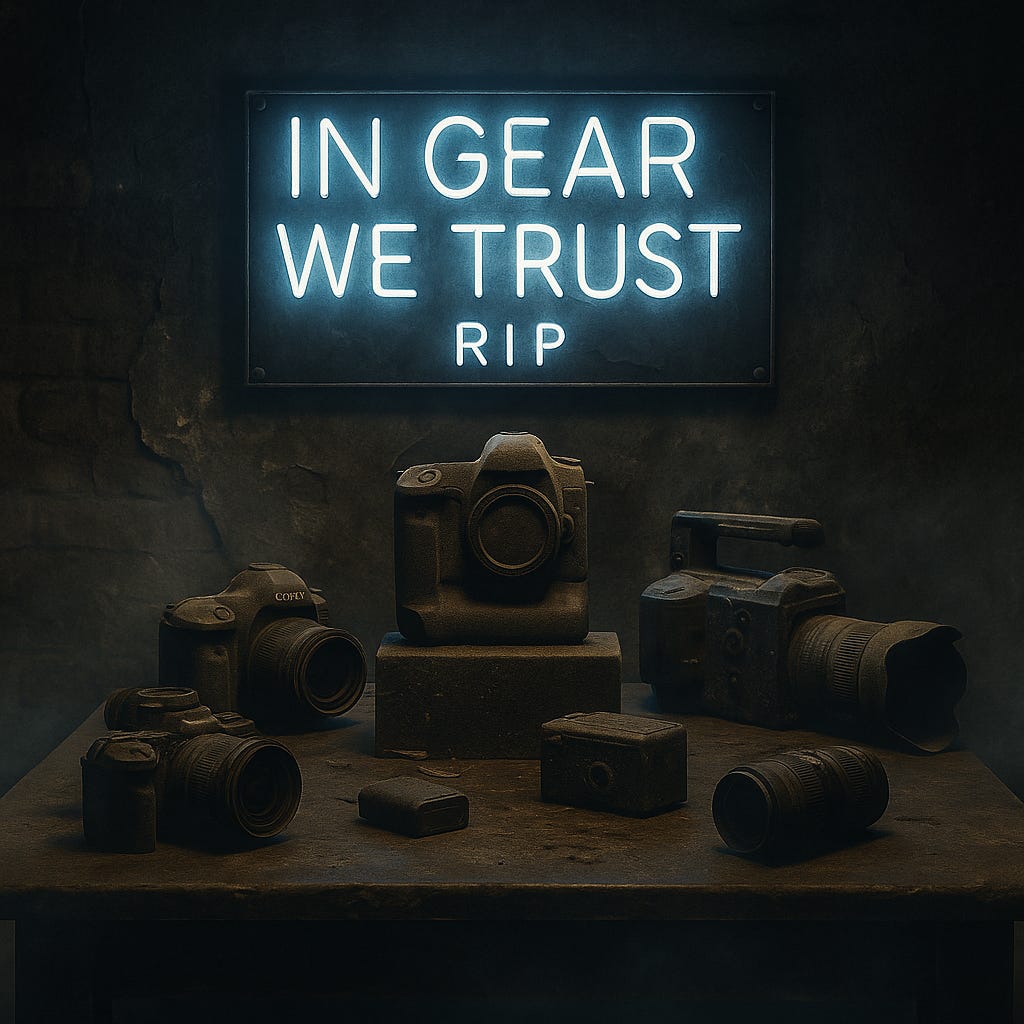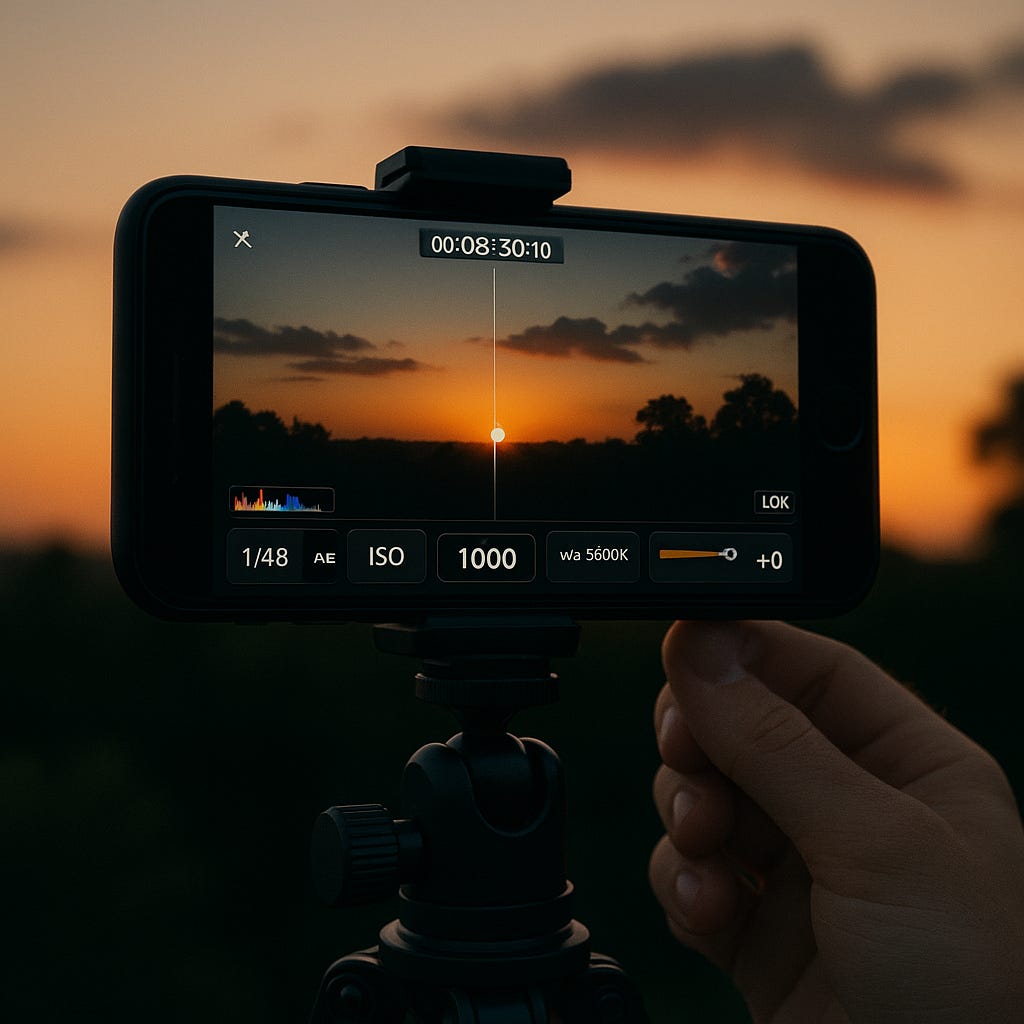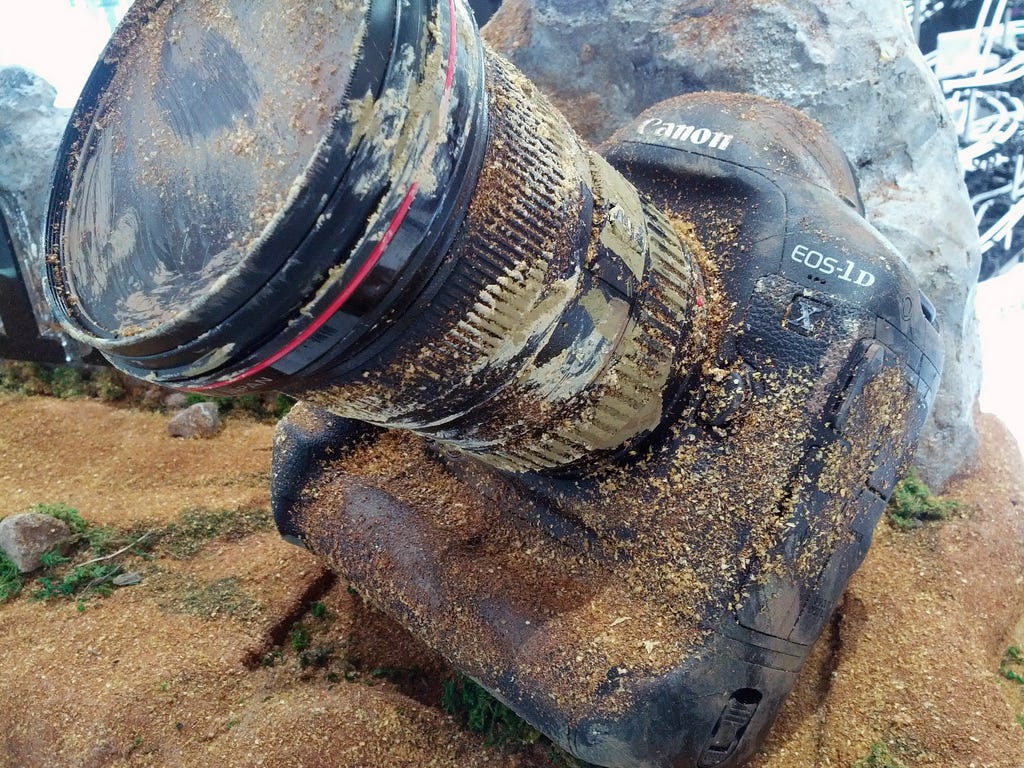The Camera Gear Wars are Over. Smartphones Won.
YouTube Confidential: A Decade Under the Influence
As always, I’m Taylor Gunn and remember… It’s FREE to Subscribe and helps me a lot.
The Death of Gear Worship
There was a time (not that long ago) when the tools did matter. When the camera you shot on was shorthand for your legitimacy. If you rolled into a shoot with a battered Canon 5D, or 1DX Mark ii with the battery carriage add-on… people gave you a little nod. A small head tilt of respect and thought…
“Ah, yes. This guy knows his shit.”
Clients swooned. Onlookers adoroed. And Fellow Filmmakers and Photographers drooled. But alas…
It was all theater.
The wannabe filmmaker golden age was the most expensive game of cosplay you’ve ever seen.
Gear porn masquerading as professionalism. The industry was built on it — entire cottage economies of YouTube gear reviewers, affiliate marketers, rental houses, and insecure freelancers feeding the beast. If you didn’t have the latest cinema camera, you weren’t “serious.” You were an amateur, a hobbyist. An Instagram tourist in a land of real filmmakers.
And then smartphones came along changed the landscape.
And then then Capcut and Adobe Rush changed it again.
And then Sean Baker came along and nuked the whole goddamn thing.
Tangerine, an incredible independant film, was shot on a fucking iPhone 5S. No RED. No Arri. Just a man, a story, some cheap lenses, and the audacity to ignore the rules. That little plastic brick that every suburban soccer mom used to text family recipes had now birthed a Sundance darling. And for one brief moment, the gearheads on YouTube forums collectively soiled themselves.
This wasn’t supposed to happen.
Baker refused their sick, incestuous religion of gear worship. And instead of parsing out pro-sumer merchandise for his professional needs, he grabbed the tool within reach and made art.
It wasn’t a gimmick. It was proof.
Proof that the world of filmmaking, storytelling, content creation… was all reaching a singularity of quality and affordability and to that, I say… “Amen.”
“I can’t shoot my passion project yet… I need better glass.”
“Once I get that full-frame body, then I’ll finally start my YouTube channel.”
“I don’t want to release this yet. I’m waiting to upgrade to 10-bit ProRes RAW.”
Those days are gone, and revealed for what they always were… Cowardice wrapped in retail therapy.
The lie is so seductive because it feels like progress. You spend thousands. You build your rig. You watch unboxing videos. You tweak your settings — This is the lowest form of mental masterbation in my creative book, and one that took part in for quite literally YEARS.
It’s called “GAS”
Gear Aquisition Syndrome. A sickness that plagued me for the better part of a decade. But now…
Smartphones cured that wretched ailment.
The camera is in your pocket. The editing bay is in your pocket. The distribution platform is in your pocket. The only thing missing is your balls to press record… (which may be in the pocket of those people whom you’re overconcerned with what they’ll say, another article for another time.)
The Editing Room Is Dead — You Carry It Now
Once upon a time, editing was sacred ground. Dark rooms lined with racks of hard drives, multi-thousand dollar color accurate monitors, and surface control panels.
You needed gear, space, training, and hardware just to stitch footage together. It was slow. Expensive. Exclusive. That exclusivity became the last defense for the gear-obsessed: "Sure, anyone can shoot, but real editing still takes serious hardware."
Not anymore.
There is full-on post-production happening in transit. In bathrooms. In bed. In the fucking airport terminal and yes… on the flight as well.
The entire idea of “going back to the edit bay” is now a joke. You carry your edit bay everywhere you go.
And here’s the real kicker: these mobile apps aren’t toys. They’re powerful, feature-rich, professional editing tools that would’ve cost you tens of thousands of dollars 15 years ago.
You want motion graphics? Keyframing? Masking? Audio ducking? Multicam sync? Color grading? It's all there.
Your phone isn’t a compromise. It’s the most accessible, frictionless way to learn real post-production on earth. And the more you use it, the faster you learn. Because editing mastery isn’t built on gear… it’s built on reps.
My wife asked me recently to help her edit one of her IG reels in capcut… I’d never used it before, and within 20 minutes I have 10 layers of audio and video, sound design, etc… the fundemntals I knew could all easily be applied… and if they could be easily applied, that means they could be learned as well inside that little, beautiful mobile app.
All it takes is reps.
Reps teach you rhythm. Timing. Emotional pacing. How to use silence. When to punch the music. How to shape a scene with sound design. How to structure tension and release.
Smartphones, in this year of our Lord 2025… have officially democratized the medium of film and all of its bloated pipelines.
Cinematic Mastery Lives In The Frame Rate And Your Settings
Let me give you the cheat code:
Switch your phone to 24fps.
That’s it. That’s the single biggest upgrade you can make today. And it doesn’t cost you a fucking dime.
24fps is what your brain subconsciously associates with narrative filmmaking. It’s the standard for every film you’ve ever emotionally connected with. The slight motion blur, the elegant cadence of movement — it tells your brain: this is a story. This isn’t live TV. This isn’t sports. This isn’t home video. This is cinema.
You can shoot the exact same scene at 30fps and 24fps, and one will feel like a TikTok, and one will feel like a feature film. It’s that powerful.
Now, once you flip that switch, you’re ready to take full control. Because smartphones don’t actually lack capability… They just hide it behind friendly “point-and-shoot” interfaces designed for boomer thumbs.
You want to shoot cinematic footage? Learn manual exposure:
ISO control keeps your image clean and grain-free.
Shutter speed matched to your frame rate (1/48 for 24fps) gives you natural motion blur.
White balance lock prevents your image from shifting colors mid-shot like a bad soap opera.
Exposure compensation helps you light for mood, not just clarity.
Apps like Filmic Pro, Beastcam, or ProTake will give you granular control. Suddenly your phone behaves like a $10K cinema rig. Not because the hardware changed, but because you took control of the process.
And once you pair manual exposure with intentional lighting, you’re playing in the big leagues.
Lighting is where amateurs die. They think expensive cameras will save them. But you can shoot garbage on a $60K Alexa if you light it poorly.
Here’s the dirty secret of lighting:
You don’t need an ARRI SkyPanel.
You don’t need $800 LED panels.
You need a few $20 RGB lights from Amazon and a cheap can of atmosphere spray.
That’s it.
With three practical lights, some fog, aiming to the film the “shadow side” of your subject and basic understanding of contrast, leading lines and movement… you can turn your bedroom into a film set. Backlight your fog. Rim light your subject. Create depth. Use color contrast to separate foreground and background. These are skills won through experience, not purchased.
Lighting mastery will elevate your phone footage beyond what most DSLR owners can achieve.
Sound Was The Final Gatekeeper — Now It’s Open Season
For years, audio was the weak spot. Smartphones could capture great video with a little work, but sound was always the giveaway.
Bad audio kills everything. You can forgive shaky visuals. You can forgive blown exposure. You cannot forgive echoey, tinny, garbled dialogue.
I forget where I heard it, but someone once said “The audience will forgive shit video with great audio, but never great video and shit audio.”
In my experience, I find that to be a cinematic cardinal truth.
Anyways…
Enter DJI’s wireless lav mics. Enter Rode’s Wireless Go. Enter the entire new generation of idiot-proof wireless systems that pair seamlessly with phones. Suddenly, you have studio-grade audio in your pocket. Crystal clear. Wind protected. Real-time monitoring. No bulky recorders. No complicated mixers.
For $300, your iPhone can now capture dialogue cleaner than the news networks were broadcasting five years ago.
Audio is no longer the bottleneck and with that, the final gatekeeper has fallen.
When you combine crisp dialogue with your cheap RGB lighting and your 24fps manual exposure footage, you are producing something head-and-shoulders above those who put NO TIME into learning their craft.
Think about that.
A phone.
A lav mic.
Some lights.
And knowledge.
You’re running a full production studio out of your backpack while legacy production companies still squabble over has gets to drive the grip truck because it’s a bitch to park.
The playing field isn’t just leveling… It’s tilting toward the fast, the nimble, and the hungry.
The Law Of Reps: Why Lightweight Shooters Win The Marathon
Here’s the brutal truth most camera nerds never want to hear:
The bigger your gear, the less you shoot.
Friction kills frequency. And frequency is the only real path to mastery.
Every time you have to charge multiple batteries, pack multiple bags, rig multiple mounts, calibrate multiple systems… You hesitate. You second-guess whether it’s worth setting up. And in that hesitation, you lose reps.
Filmmaking mastery lives in reps. Not single “perfect” projects. Volume. Iteration. Testing. Failing. Learning. Adjusting.
Your phone removes that friction. It’s always there. Always ready. Always inviting you to capture something. To experiment. To learn exposure. To experiment with lighting. To practice handheld stability via ninja walking which is a very cool and important skill for both filmmaking and assassinating your enemies.
The person who shoots 10 times a week on a phone will outpace the person who shoots once a month on a full rig. Because they simply have more mileage.
And filmmaking, like anything else, rewards mileage.
This is why the kids you dismiss as "just TikTokers" are getting scary good. They’re shooting constantly. They’re experimenting daily. They’re cutting scenes in transit. They’re iterating in real time.
They’re racking up a decade of practice in 18 months.
I have a theory about this that other experienced filmmakers will understand…
So much of “how good” something looks, happens in the mind well before it’s ever shot, drawing on your experience to know how a thing will look and feel on camera on the day of the shoot. Then, when it falls apart (as things tend to do on set) it’s that same experience that bends the situation to your will either to nail what you had in mind, or create a happy accident on set for something even better.
All of this is thanks to experience. Experience is King.
The Algorithm Doesn’t Give A Shit About Your Gear
YouTube doesn’t care how expensive your camera is. (Kinda… there’s an added benefit to uploading in 4k, but that’s another article)
Neither does TikTok. Or Instagram. Or any platform, for that matter.
The algorithm cares about one thing: Did you keep people watching?
Retention. Engagement. Velocity.
Did your thumbnail make them click?
Did your opening hook make them stay?
Did your pacing hold attention?
Did your editing create tensions and payoffs and satisfaction?
Did your energy make people binge more?
That’s it.
Your dynamic range? Irrelevant.
Your full-frame shallow depth of field? Irrelevant.
Your $2,000 gimbal? Irrelevant.
Audiences don’t share videos because they’re pixel-peeping your sharpness. They share because you made them feel something.
Smartphones let you focus on story. On delivery. On iteration speed. On volume. You shoot more. You post more. You get feedback faster. You adapt faster.
The people winning this game aren’t the ones hoarding gear.
They’re the ones who’ve embraced velocity.
Every creative industry fights the same pattern:
The printing press killed the scribes.
The electric guitar pissed off classical purists.
YouTube decimated network television.
Now smartphones are tearing down price-point productions.
The only thing standing between you and mastery now is your discipline.
Pick up your phone.
Press record.
Tell a story.
Light it well. Capture clean sound. Edit with rhythm. Practice relentlessly. Iterate fast.
The war is over.
The snobs lost.
The revolution already happened while they were still arguing on forums about bitrate compression.
And now? Now it’s your turn.
LINKS BELOW…
WHAT IS YOUTUBE CONFIDENTIAL?
IN MANY WAYS, YouTube Confidential is a love letter to YouTube, the industry that gave a wretch like me more than I ever deserved or thought possible. In other ways, it’s a road map of scars, burnt bridges, and ego-deaths outlining my checkered career – that at times, is far more honest then I’d ever wished to put down on paper.
My justification for said honesty is that I truly believe that in doing so, I’ll help others avoid my mistakes and avoid years of wastrel and wayward behavior and get to where they want to be faster. That means more money, less bullshit, and doing meaningful, fulfilling creative work without all the drama and stress that is all too common in our industry.
For the common reader, I hope "YouTube Confidential" is good for a few laughs while exposing the creative malpractice that takes place daily in the industry’s labor ecosystem.
The editors, strategists, and thumbnail artists I work with and talk to on a daily basis are the lifeblood of this industry, and I hope to shine a spotlight on those dark, damp and downright abused corners in this place we all call home.
SOCIALS:












Have you tried shooting a YouTube video on your phone? I mean, a full 10 minute video?